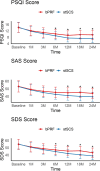Comparative long-term efficacy of short-term spinal cord stimulation versus bipolar pulsed radiofrequency for refractory postherpetic neuralgia: a 24 month prospective study
- PMID: 40221810
- PMCID: PMC11993966
- DOI: 10.1186/s40001-025-02560-0
Comparative long-term efficacy of short-term spinal cord stimulation versus bipolar pulsed radiofrequency for refractory postherpetic neuralgia: a 24 month prospective study
Abstract
Background: Postherpetic neuralgia (PHN) is a debilitating neuropathic pain condition that persists after herpes zoster infection, often resistant to conventional medications. This study compares the long-term efficacy and safety of short-term spinal cord stimulation (stSCS) versus bipolar pulsed radiofrequency (bPRF) in managing refractory PHN.
Methods: In this prospective, controlled observational study, 140 PHN patients (aged ≥ 18 years; PHN duration ≥ 3 months) with inadequate pain relief from standard therapies were enrolled and randomized equally into two groups (n = 70 each). The stSCS group received percutaneous implantation of an 8-contact electrode for temporary neuromodulation, while the bPRF group underwent application of controlled high-frequency pulses to the dorsal root ganglion. Outcome measures included pain intensity (VAS, NRS), neuropathic pain characteristics (DN4), quality of life (SF-36, EQ-5D), sleep quality (PSQI), and psychological status (SAS, SDS), assessed at baseline and at follow-up intervals over 24 months.
Results: Both stSCS and bPRF achieved significant short-term pain relief. However, from 6 to 24 months post-treatment, the stSCS group demonstrated significantly lower VAS scores and superior pain control compared to the bPRF group. In addition, improvements in sleep quality and emotional well-being were more pronounced in the stSCS group at 12, 18, and 24 months. Both treatments exhibited favorable safety profiles with only minor, transient adverse events reported.
Conclusions: While both stSCS and bPRF effectively alleviate pain in patients with refractory PHN, stSCS offers superior long-term benefits in pain reduction, sleep quality, and psychological outcomes. These findings suggest that stSCS may be the preferred neuromodulation strategy for patients with chronic PHN requiring sustained symptom management.
Keywords: Bipolar pulsed radiofrequency; Pain management; Postherpetic neuralgia; Short-term SCS.
© 2025. The Author(s).
Conflict of interest statement
Declarations. Ethics approval and consent to participate: This study was approved by the Institutional Review Board of Shandong Provincial Hospital (No. 2021-slyy-018). Competing interests: The authors declare no competing interests.
Figures




Similar articles
-
Short-Term Spinal Cord Stimulation or Pulsed Radiofrequency for Elderly Patients with Postherpetic Neuralgia: A Prospective Randomized Controlled Trial.Neural Plast. 2022 Apr 27;2022:7055697. doi: 10.1155/2022/7055697. eCollection 2022. Neural Plast. 2022. PMID: 35529453 Free PMC article. Clinical Trial.
-
Efficacy of Pulsed Radiofrequency or Short-Term Spinal Cord Stimulation for Acute/Subacute Zoster-Related Pain: A Randomized, Double-Blinded, Controlled Trial.Pain Physician. 2021 May;24(3):215-222. Pain Physician. 2021. PMID: 33988940 Clinical Trial.
-
Efficacy of Short-Term Spinal Cord Stimulation in Acute/Subacute Zoster-Related Pain: A Retrospective Study.Pain Physician. 2017 Jul;20(5):E633-E645. Pain Physician. 2017. PMID: 28727708
-
Comparing the efficacy and safety of short-term spinal cord stimulation and pulsed radiofrequency for zoster-related pain: A systematic review and meta-analysis.Medicine (Baltimore). 2022 Mar 18;101(11):e29073. doi: 10.1097/MD.0000000000029073. Medicine (Baltimore). 2022. PMID: 35356934 Free PMC article.
-
From Short-Term Relief to Long-Term Management: A Meta-Analysis of Temporary Spinal Cord Stimulation and Pulsed Radiofrequency in Postherpetic Neuralgia.Neuromodulation. 2025 Aug;28(6):923-936. doi: 10.1016/j.neurom.2025.03.076. Epub 2025 Apr 25. Neuromodulation. 2025. PMID: 40278804 Review.
References
-
- Hu J, Zhong LZ, Li TT, Jia QY, Li HM. Study of risk factors of postherpetic neuralgia. Zhonghua Yi Xue Za Zhi. 2022;102(40):3181–5. - PubMed
-
- Abu El-Hamd M, Abd Elaa SG, Abdelwahab A. Postherpetic neuralgia: an update of etiopathogenesis. Sohag Med J. 2022;26(1):30–3.
Publication types
MeSH terms
Grants and funding
LinkOut - more resources
Full Text Sources
Medical

